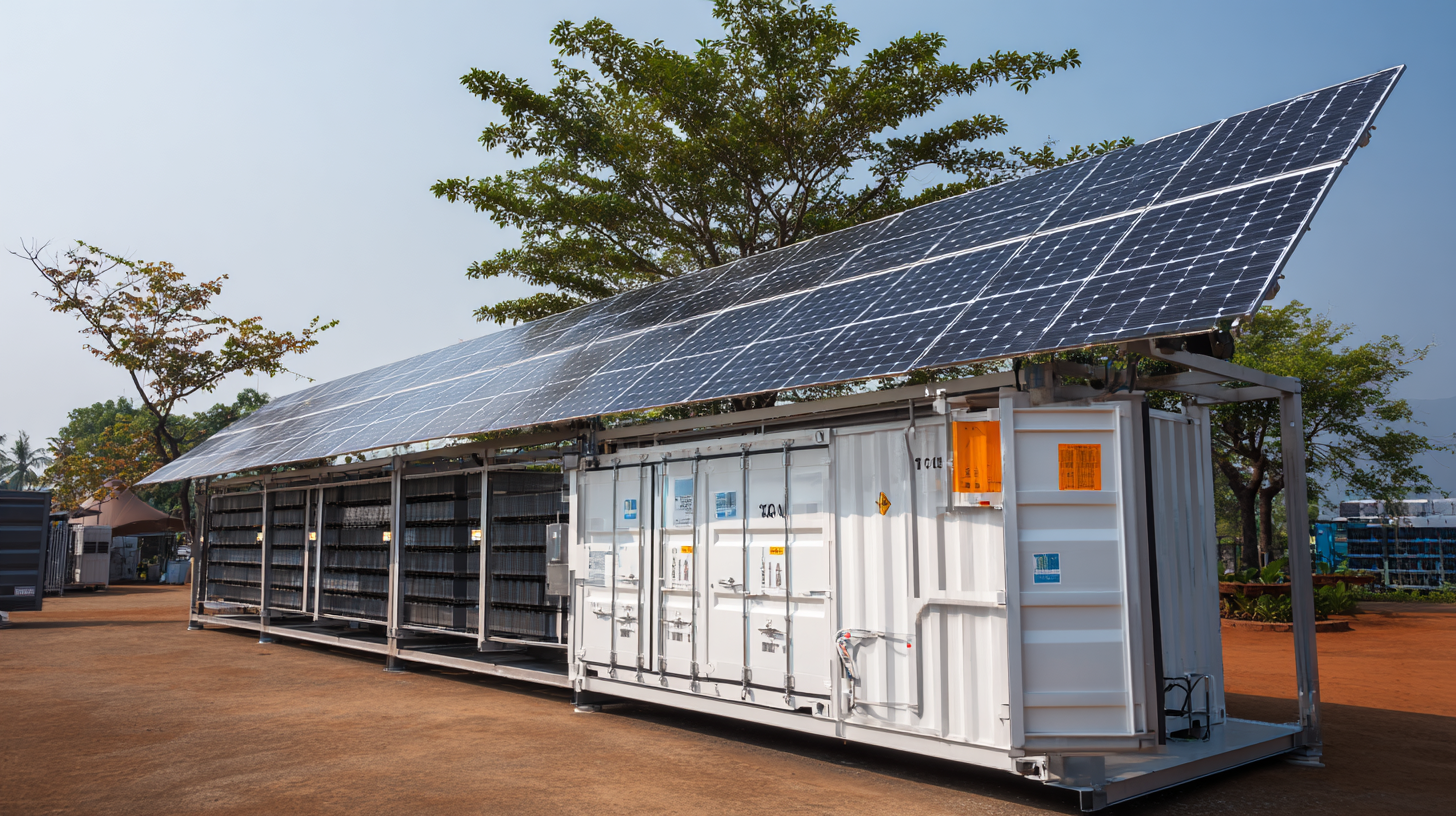As the world increasingly pivots towards sustainable energy solutions, the spotlight is firmly on Solar PV and Battery Storage systems as key players in the transition to greener alternatives. By 2025, the market for solar photovoltaic (PV) technology and battery storage solutions is expected to undergo significant transformations driven by advancements in technology, regulatory policies, and changing consumer preferences. This blog aims to provide a comprehensive checklist for understanding the current market trends and projected developments in the Solar PV and Battery Storage landscape. From evaluating innovative products to assessing emerging business models, this exploration will equip readers with essential insights to navigate the evolving energy landscape. Join us as we delve into the future outlook, highlighting the opportunities and challenges that lie ahead for stakeholders in the Solar PV and Battery Storage sectors.

The solar photovoltaic (PV) and battery storage markets are anticipated to experience robust growth by 2025, driven by technological advancements, policy support, and increasing consumer awareness. Recent statistics indicate that the global solar PV market alone is projected to expand at a compound annual growth rate (CAGR) of over 20%, reaching an installed capacity of more than 1,200 GW by 2025. This surge is attributed to declining costs of solar modules and the rising demand for clean energy, as countries aim to cut down on fossil fuel dependency.
In parallel, the battery storage sector is expected to witness similar growth, with projections suggesting that the global battery storage capacity could exceed 300 GWh by 2025. This growth is largely fueled by the need for efficient energy management systems and enhanced grid stability. Key players in the battery market are investing heavily in research and development to advance energy density and longevity, making storage solutions more viable for both residential and commercial applications. As consumers and businesses alike seek sustainable energy solutions, the synergies between solar PV and battery storage are set to redefine the energy landscape by 2025.
As we look toward a future dominated by renewable energy, innovations in solar photovoltaic (PV) technology and energy storage systems are paramount for enhancing efficiency. Emerging technologies such as bifacial solar panels, which capture sunlight on both sides, and perovskite cells, known for their high efficiency and lower production costs, are reshaping the landscape of solar energy. These advancements not only maximize energy output but also make solar solutions more accessible for residential and commercial applications, paving the way for widespread adoption.

In the realm of energy storage, the development of advanced lithium-sulfur batteries and solid-state batteries promises significant improvements over traditional lithium-ion systems. These materials offer higher energy densities, longer lifespans, and increased safety, addressing many of the limitations associated with current battery technologies. As these innovations gain traction, we can expect a seamless integration between solar PV systems and energy storage, creating a robust infrastructure that supports sustained clean energy supply. The convergence of these technologies will ultimately propel us towards a more sustainable energy future by 2025 and beyond.
As the solar energy sector continues to evolve, regulatory changes are playing a crucial role in shaping market dynamics. Recent studies indicate that well-structured solar photovoltaic policies can significantly enhance adoption rates. For instance, the effectiveness of solar policies in Dubai and Abu Dhabi highlights that comprehensive regulations combined with robust incentives can drive substantial investments and facilitate growth in this sector. A report showed that regions with clear regulatory frameworks see up to a 30% increase in solar installations compared to those lacking such guidance.
Tips: To stay ahead in the solar market, consider keeping abreast of local and national policy changes. Engage with trade associations that provide updates on legislative trends impacting solar energy adoption.
Moreover, as companies pivot towards sustainability, integrating solar energy can lead to improved profitability. A recent analysis suggested that organizations adopting renewable energy practices could boost their financial performance by up to 20%. This trend not only supports corporate sustainability goals but also appeals to a growing base of environmentally conscious consumers.
Tips: Businesses looking to adopt solar energy should conduct thorough financial analyses to assess potential ROI and explore partnerships that can streamline implementation and maximize benefits.
This chart illustrates the projected growth in solar PV and battery storage capacities from 2023 to 2025. The significant increase in both solar and battery storage capacities highlights the expanding adoption of renewable energy solutions in response to regulatory changes and market dynamics.
The demand for solar PV and battery solutions in residential markets is rapidly increasing, driven by evolving consumer trends and the urgent need for sustainable energy sources. The global residential energy storage market is projected to surge from $1.05 billion in 2023 to $3.92 billion by 2029, reflecting a significant compound annual growth rate (CAGR) of 24.37%. This growth exemplifies how homeowners are increasingly investing in energy independence, primarily through enhanced power backup systems.
Moreover, the solar battery market continues to show robust expansion, with projections indicating a rise from $297.13 billion in 2025 to an astounding $1,001.31 billion by 2033, driven by a CAGR of 16.4%. As the capabilities of residential batteries improve, consumers are becoming more inclined to adopt these technologies for both financial savings and environmental benefits.
**Tips:** When considering solar PV and battery solutions, assess your energy consumption patterns to determine what system best fits your needs. Additionally, stay informed about local incentives or rebates that can significantly reduce your investment costs. Finally, opting for high-quality and efficient systems will not only bolster your savings but also enhance the reliability of your energy supply.
| Year | Residential Solar PV Installations (MW) | Battery Storage Capacity (GWh) | Market Growth Rate (%) | Consumer Adoption Rate (%) |
|---|---|---|---|---|
| 2023 | 25,000 | 15 | 10% | 15% |
| 2024 | 30,000 | 25 | 12% | 20% |
| 2025 | 40,000 | 50 | 15% | 25% |
The solar photovoltaic (PV) and battery storage sectors are poised for substantial growth by 2025, driven by increasing investment opportunities and the urgent need for sustainable energy solutions. According to a report from the International Energy Agency (IEA), the global capacity of solar PV is expected to quadruple within this timeframe, reaching 5,000 GW. This surge presents significant investment potential for stakeholders, including both established companies and new entrants. However, challenges such as supply chain disruptions and regulatory hurdles could hinder this growth, necessitating strategic planning and adaptability.
Investors looking to enter the solar PV and battery storage markets should consider a few key tips. Firstly, understanding local regulations and incentives is crucial, as government policies can greatly influence profitability. Secondly, investing in innovative technologies, such as solid-state batteries, could provide a competitive edge, given their potential to enhance energy efficiency and storage capacity. Lastly, diversifying investments across different regions can mitigate risks associated with market volatility and local economic fluctuations.
The integration of solar PV with battery storage solutions is becoming increasingly important for achieving energy resilience. According to BloombergNEF, the global battery market for stationary storage is anticipated to grow from 5 GWh in 2020 to 1,200 GWh by 2030. This trend underscores the necessity for investors to focus not only on solar technology but also on advancements in battery storage systems, ensuring they capitalize on the growing intersection of these two critical sectors.
